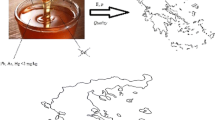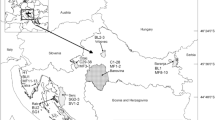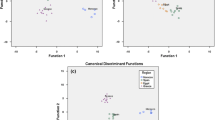Abstract
Major macronutrient concentrations (K, Ca, Mg, Na, P, and S) and element ratios were determined in 140 Hungarian mono-floral honey samples (acacia, linden, sunflower, rape, chestnut, forest, silk grass, and facelia) by inductively coupled plasma-optical emission spectrometry (ICP-OES). One-way ANOVA (LSD and Dunnett T3 test) and linear discriminant analysis (LDA) were used to determine the botanical origin based on the element content and element ratio of different honey types. Analysing six element concentrations in the honeys of different botanical origin with LDA allowed the botanical origin of 96% of honeys to be predicted. Reducing the examined elements to K, Mg, and Na increased the accuracy of predictions, but it was still not possible to distinguish acacia and facelia honeys. However, examination of element ratios showed that K/Na and K/Mg ratios were able to separate every honey type from each other with 100% cross-validation. It is concluded that using macro-element ratios rather than macro-element concentrations, it is possible to precisely discriminate the floral origin of honey samples.




Similar content being viewed by others
References
Gulyás S, Bartók T, Stefanik K (1983) Adatok a nektár és a méz fémeselem tartalmához. Méhészet 31:4
Alvarez-Suarez JM, Tulipani S, Romandini S, Bertoli E, Battino M (2010) Contribution of honey in nutrition and human health: a review. Med J Nutrition Metab 3:15–23
Crane E (1975) Honey: comprehensive survey. Heinemenn, London, p 608
Feldman Zs (2016) Hungarian Apiary National Program. Földművelésügyi Minisztérium, Budapest
Czipa N, Novák A, Kovács B (2016) Fajtamézek botanikai eredetének vizsgálata (analysis of the botanical origins of monofloral honey types). Élelmvizsg Közl (J Food Invest) 62(4):1317–1324
Nayik GA, Suhag Y, Majid I, Nanda V (2016) Discrimination of high altitude Indian honey by chemometric approach according to their antioxidant properties and macro minerals. J Saudi Soc Agric Sci. https://doi.org/10.1016/j.jssas.2016.04.004
Kaygusuz H, Tezcan F, Bedia Erim F, Yildiz O, Sahin H, Can Z, Kolayli S (2016) Characterization of Anatolian honeys based on minerals, bioactive components and principal component analysis. LWT Food Sci Technol 68:273–279
Belay A, Haki GD, Birringer M, Borck H, Addi A, Baye K, Melaku S (2017) Rheology and botanical origin of Ethiopian monofloral honey. LWT Food Sci Technol 75:393–401
Kortesniemi M, Slupsky CM, Ollikka T, Kauko L, Spevacek AR, Sjövall O, Yang B, Kallio H (2016) NMR profiling clarifies the characterization of Finnish honeys of different botanical origins. Food Res Int 86:83–92
Popek S, Halagarda M, Kursa K (2017) A new model to identify botanical origin of Polish honeys based on the physicochemical parameters and chemometric analysis. LWT Food Sci Technol 77:482–487
Oroian M, Amariei S, Leahu A, Gutt G (2015) Multi-element composition of honey as a suitable tool for its authenticity analysis. Pol J Food Nutr Sci 65(2):93–100
Czipa N, Diósi G, Phillips C, Kovács B (2017) Examination of honeys and flowers as soil element indicator. Environ Monit Assess 189:412
MSZ 6950-3:1977: MÉZ–Mikroszkópos vizsgálat,
Kovács B, Győri Z, Prokisch J, Loch J, Dániel P (1996) A study of plant sample preparation and inductively coupled plasma emission spectrometry parameters. Commun Soil Sci Plant Anal 27(5–8):1177–1198
Bilandzic N, Gačić M, Ðokić M, Sedak M, Šipušić DI, Končurat A, Gajger IT (2014) Major and trace elements levels in multifloral and unifloral honeys in Croatia. J Food Comp Anal 33:132–138
Bontempo L, Camin F, Ziller L, Perini M, Nicolini G, Larcher R (2016) Isotopic and elemental composition of selected types of Italian honey. Measurement 98:283–289
Di Bella G, Lo Turco V, Potorti AG, Bua GD, Fede MR, Dugo G (2015) Geographical discrimination of Italian honey by multi-element analysis with a chemometric approach. J Food Comp Anal 44:25–35
Author information
Authors and Affiliations
Corresponding author
Ethics declarations
Conflict of interest
There is no conflict of interest.
Compliance with ethics requirements
There has not been any research involving human or animal participants performed.
Rights and permissions
About this article
Cite this article
Czipa, N., Alexa, L., Phillips, C.J.C. et al. Macro-element ratios provide improved identification of the botanical origin of mono-floral honeys. Eur Food Res Technol 244, 1439–1445 (2018). https://doi.org/10.1007/s00217-018-3057-9
Received:
Revised:
Accepted:
Published:
Issue Date:
DOI: https://doi.org/10.1007/s00217-018-3057-9




